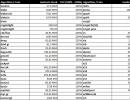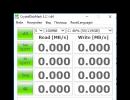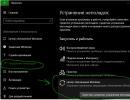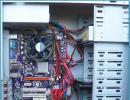Measure the speed of the ssd drive. CrystalDiskMark program: testing the read and write speed of hard drives
No matter what speed the manufacturer indicates in the characteristics of their SSDs, the user always wants to check everything in practice. But it is impossible to find out how close the drive speed is to the declared one without the help of third-party programs. The most that can be done is to compare how quickly files are copied on a solid-state drive with similar results from a magnetic drive. In order to find out the real speed, you need to use a special utility.
SSD speed test
As a solution, we will choose a simple program called . It has a Russian interface and is very easy to use. So let's get started.
Immediately after launch, the main window will open in front of us, which contains all the necessary settings and information.

Before starting the test, we will set a couple of parameters: the number of checks and the file size. The accuracy of the measurements will depend on the first parameter. By and large, the five checks that are installed by default are quite enough to obtain correct measurements. But if you want to get more accurate information, you can set the maximum value.

The second parameter is the size of the file that will be read and written during tests. The value of this parameter will also affect both the measurement accuracy and the test execution time. However, in order not to reduce the service life of the SSD, you can set the value of this parameter to 100 Megabytes.

After setting all the parameters, we proceed to selecting a disk. Everything is simple here, open the list and select our solid-state drive.

Now you can proceed directly to testing. CrystalDiskMark offers five tests:
- Seq Q32T1– testing sequential writing/reading of a file with a depth of 32 per thread;
- 4K Q32T1– testing random writing/reading of blocks of size 4 Kilobytes with a depth of 32 per thread;
- Seq– testing sequential write/read with depth 1;
- 4K– testing random write/read with depth 1.
Each of the tests can be run separately; to do this, just click on the green button of the desired test and wait for the result.

You can also do a full test by clicking on the All button.

In order to get more accurate results, it is necessary to close all (if possible) active programs (especially torrents), and it is also desirable that the disk is no more than half full.
Since in everyday use of a personal computer the random method of reading/writing data is most often used (80%), we will be more interested in the results of the second (4K Q32t1) and fourth (4K) tests.
Now let's analyze the results of our test. An ADATA SP900 disk with a capacity of 128 GB was used as an “experimental” disk. As a result, we got the following:
- With the sequential method, the drive reads data at a speed 210-219 Mbit/s;
- recording with the same method is slower - only 118 Mbit/s;
- reading with a random method with a depth of 1 occurs at speed 20 Mbit/s;
- recording using a similar method - 50 Mbit/s;
- read and write with depth 32 - 118 Mbit/s and 99 Mbit/s, respectively.

It is worth paying attention to the fact that reading/writing is performed at high speeds only with files whose volume is equal to the buffer size. Those with larger buffers will be read and copied more slowly.
So, with the help of a small program we can easily estimate the speed of the SSD and compare it with what the manufacturers indicate. By the way, this speed is usually overestimated, and using CrystalDiskMark you can find out exactly how much.
The hard drives of computers and laptops store files, the operating system, and everything that is in the device’s memory. The speed and stability of a PC largely depends on how quickly data is exchanged on different segments of the hard drive. Modern users are offered HDD and SSD drives; each option can be tested for speed and stability.
What should be the operating speed?
There is no single benchmark for hard drive speed. However, there are recommended speeds for different types of equipment.
HDDs
The data exchange speed depends on the type of connection of the drive to the motherboard:
- SATA1 – 150 MB/s;
- SATA2 – 300 MB/s;
- SATA3 – 600 MB/s.
Most modern computers use SATA2 types. The maximum operating speed for them is 750 MB/s. Despite the listed capacities, the average data transfer speed is on average 85 MB/s.
SSD drives
SSD drives are much faster than HDDs. Power users and gamers prefer to install this type of hard drive. SSDs are more expensive and offer less storage space, but they don't have mechanical parts that wear out and slow down your hardware.
On average, the speed of SSD drives exceeds HDDs by 55-80 times. Minimum speed 780 Mb/s.
Checking with the standard WinSat utility
To work with the built-in utility, you need to enter the command line:
- Click Start or the Windows button, go to Programs – Accessories – Command Prompt;
- Click Start, enter cmd in the search bar, enter key;
- Press the Win+R key combination, enter cmd, click on the “Run” button.
When the black command line window opens, you need to enter a simple entry “winsat disk” and press Enter. The system will take some time to complete the check.
When the cursor for entering records appears on the command line again, you can evaluate the result. Close attention should be paid to the following entries:
- Disk Sequential 64.0 Read – speed at which the memory reads sequential blocks;
- Disk Random 16.0 Read – the speed at which the memory reads random blocks;
- Disk Sequential 64.0 Write – the speed at which the hard drive writes data in sequential blocks.
The far right column gives a performance rating for each type of operation. The younger the version of Windows, the better the score you should expect.
Checking with third party programs
Third-party software is developed for system administrators and ordinary users who undertake testing and repairing their devices.
CrystalDiskMark
The utility is lightweight and distributed free of charge. You can download it from the official website of the developer.
Once launched, CrystalDiskMark performs a comparative analysis of the hard drive's speed when performing various operations. A small window displays information about the equipment's capabilities when reading and writing data.
CrystalDiskInfo
It is also a free program that can be downloaded from the developer’s website. The utility must be installed on your PC and launched. The working window displays information not only about the operating speed, but also the current state of the hard drive.
CrystalDiskInfo is designed for timely verification, evaluation and diagnosis of your hard drive. With the utility it is possible to prevent breakdowns and see what the current state of the equipment is.
HD Tune
Another utility that is distributed free of charge. HD Tune can be downloaded from foreign developers.
The program is suitable for more advanced users, because... It may be difficult to decipher the result.
AS SSD Benchmark
The utility was created by a single programmer, it is free and similar in appearance to CrystalDiskMark. The main difference is the advanced interface.

Hi all! I think it’s no secret to anyone that one of the most important components inside your computer or laptop is the drive that contains the operating system. A completely logical consequence is the question of how to perform a hard drive (or SSD, if the computer is newer) speed test.
If your operating system is installed on a slow hard drive, then it doesn’t matter how powerful your central processor or RAM is - Windows itself and installed programs will start very reluctantly and you won’t be able to enjoy full multitasking.
In the age of the Internet, there are quite a lot of publications that will tell you about almost any drive model on sale. In addition, there are a huge number of programs for checking the speed of a hard drive, the result of which will be an understanding of what your drive is capable of.
There are many paid utilities, like PCMark or PassMark, that can test the entire system and can often be found in tests from well-known publications. We're going the other way and I'm going to tell you about four free ways to test the speed of your hard drive or SSD.
The real performance of an HDD or SSD in a Windows environment (and not only) is determined not only by the rotation speed of the magnetic disk or the memory of the drive chips, but also by many other important factors. The drive controller, the SATA version on the motherboard, the drivers of the controller itself, the operating mode (ACHI or IDE) - all this affects the performance of the disk subsystem (even the CPU or RAM can affect the performance)
Method 1: CrystalDiskMark is our main tool
Probably the most popular tool for testing hard drive speed is CrystalDiskMark. Almost no drive testing is complete without this utility - this situation will help you compare your results and draw the right conclusions. A big plus is the program’s ability to test not only HDD/SSD, but also flash drives and other storage media.
The application has both a distribution and a portable version that does not require installation. You can download it as usual on the official website (I, as always, recommend portable).
CrystalDiskMark is incredibly easy to use. We launch the utility, select the size of the test block (in the picture below we chose 1 GB), the number of test repetitions (I chose 5 - the more repetitions, the more accurate the result) and the drive itself. We press the “all” button and wait until the program runs all the tests (by the way, you can run a separate test for each mode).

In the screenshot on the left is the SSD speed test, and on the right is the HDD. Just so you know how big the difference is between them and what kind of performance gain you will get by replacing just one component in the system
Method 2. CrystalDiskInfo - detailed information about the HDD/SSD drive
At the very beginning of the note, I already wrote that the speed test of a hard drive or SSD will not be entirely correct if we do not find out the factors affecting the performance of the disk subsystem. The CrystalDiskInfo utility will tell you a lot of interesting things about your drive, but we are interested in just one nuance - download the application from the official website and run it.
Pay attention to the line “Transfer mode”, in the picture below I have it (SATA/600 | SATA/600). These parameters must match, i.e. By connecting the SSD drive to the SATA/300 port (this is the SATA II standard), we will get a maximum exchange speed with the disk of 300 MB, and if we look at the performance test in the first method, we see that the maximum read speed was far beyond 300...
By connecting such a high-speed drive to a SATA or SATA II port, its performance will simply be limited by the performance of the controller (with classic HDDs it is not so critical, since even SATA capabilities are abundant)

In general, CrystalDiskInfo can tell you about the temperature, operating time of the drive and many other useful indicators. For owners of classic HDDs, the Reallocate Sector item will be useful - thanks to it you can predict the failure of the device
Method 3. AS SSD Benchmark - a healthy competitor to CrystalDisk from the Germans
The Germans know how to make not only films for adults, but also excellent utilities for testing the speed of a hard drive or SSD. In this case, I want to introduce you to the AS SSD Benchmark application, the functionality of which is very similar to CrystalDiskMark, but unlike it, it also shows data access time (and in general there are still minor differences).
You can download it from the official website (it’s in German, the download link is at the end of the page), the application itself is in English (many bloggers have a version exclusively in German)
The utility is portable and does not require installation, just run the application, select the required tests and press START, just like in the first method. On the left is my home SSD, on the right is the classic HDD.

Please note that in the TOOLS menu there are a couple of interesting tests that can predict the performance of the drive when copying ISO files, programs or various toys - CrystalDiskMark does not have such functionality
Method 4. HD Tune is a good tool with a visual graph
HD Tune is most likely the most famous application for testing hard drive speed, but it is in last place in today's ranking for a reason. The fact is that the free version of HD Tune has not been updated since February 2008... however, everything still works in 2k17 on the latest Windows 10. As always, you can download it from the official website (unfortunately there is no portable version)
After passing the test, we will have access to a visual reading graph (along with the maximum and minimum values, as well as the speed of data access). In general, the information is useful, but there is no way to test the disk writing speed, which is a little disappointing...

Due to its antiquities the application may not correctly detect modern drives, but this does not affect the test results in any way
Conclusion about hard drive speed testing programs
It's time to draw conclusions. We performed a hard drive or SSD speed test using four different programs (or rather, there are only three testing applications, and one more utility to make sure that the tests will be objective).
In reality, programs that allow you to check the speed of a hard drive are many times faster, but I decided to introduce you to the leaders of this niche... but if you have anything to add, I’m waiting for you in the comments.
But there is a direct dependence on the performance and speed of the entire computer. The speed of loading the OS, launching programs, copying files, exchanging data, and more depends on it.
This utility performs a hard drive speed test in this order.
- In the program window, select the number of write and read cycles. 5 is optimal.
- Specify the file size, 1 GIB is recommended.
- Select your hard drive letter (C:).

Setting up CrystalDiskMark
- Click the "All" button to begin testing.
The program will show the speed of the hard drive - reading information, it will be in column 1 - Read. In the second column you will see the write speed to the hard drive. For an SSD, 400 Mb/s is considered optimal if connected via SATA3.
To save the performance test results, take a screenshot or select “Copy test results” in the “Edit” menu; a text report will be automatically created.
AS SSD Benchmark
An excellent utility that allows you to easily and quickly test your hard drive. There is no need to install the utility. It should be used according to the same algorithm as in the utility described above.
A program that performs a hard drive test. It has a free version and a paid version (Pro). The paid version without registration has a demo period of 15 days.
- Launch the program.
- Go to the “Benchmark” tab, select the mode in which the test will be performed: “Write” or “Read”.

- If your computer has several hard drives, select the one you want to check.
- Click "Start" to start the scan.
After completing the test, the program will show the results in numbers and graphs. You will learn the following data transfer rates:
- Minimum - the smallest;
- Maximum - the largest (usually this is what manufacturers say);
- RateAverage - average;
- BurstRate - peak (often presented as real speed, but under normal conditions this is not always achieved);
- CPUUsage - CPU load during testing.
After running the test and learning the results, you will probably wonder how to increase the speed of data exchange with the disk. After all, if the speed of data exchange with the disk decreases, and there can be many reasons for this, you need to make the computer act faster. There are several ways to speed up the performance of your storage device.
- Defragmentation.
- Cleaning up registry errors and junk.
- Archiving rarely used files.
- Using a program that will detect violations of the partition structure and then correct it - Rat.
Now you can find out what the actual speed of your hard drive is, compare it with what the manufacturer claims, and how to increase it. This information will certainly help you, optimize your work on your computer, and help analyze the performance of your hard drive and improve it.
In this article we will look at the work of utilities that are used to test the speed of a hard drive. With their help, you can compare results from the same data stores and get an accurate picture of the performance of your hard drive. We do not consider details regarding the comparison of SSD-solid-state drives that claim to replace the dominant HDD “pancakes” on the market - only tests. So I’m building the article into the following parts:
- Performance: does everything depend only on the disk?
- Free speed testing programs
- – testing and comparing
Introductory
So, one of the most important devices inside a computer is the hard drive. Of course, Windows is installed there. And as a result, we can get a situation where the performance of other components against the backdrop of slow storage the data just goes out. Dozens gigabytes of RAM and more than one pair Latest generation CPU cores “under the hood”? - But slow disk equates your build to the average, despite a lot of money spent. This is why, once a user has switched to an SSD, it is unlikely that he will return to the HDD, even if he neglects the costs. But how obviously beneficial is this? In general, when considering a future purchase regarding a hard drive, the user has this picture before his eyes:
Let's put the problems right away: disk performance in Windows is not determined SOLELY by the rotation speed of the HDD pancakes or the memory capacity of SSD chips. The operation of the storage before the system starts and during the system session includes factors such as:
- characteristics
- connection type (cable or without)
- cable type (we'll talk more later)
- controller drivers and others.
So how do you know if your drive's performance is okay or if some additional tweaks are needed? It's time to test the hard drive, and I will present several programs that work under the latest versions of Windows with different types of storage. Working Condition only one thing: during the test, reduce user access to Windows to a minimum. In addition, many programs have the same characteristics and testing conditions, which you better get to know right away:
- Sequential – Sequencel- (Also seq or linear) – the speed at which the disk can read and write a block of data in the form of large files. Suitable for disks with large amounts of stored information or game partitions where file sizes on average are no less than megabyte. Sequence tests will show the maximum write/read speed that the disk can achieve when working EXACTLY with good quality movies and games.
- 4K – For-kay– hard drive speed test, as opposed to the previous one. Its task is to determine the speed of access to small files. And let me remind you, this is extremely important for the files of the OS itself. High results in 4K tests indicate high data transfer rates between the drive and Windows. This means that the system boots and runs faster from such a disk, so when choosing storage to speed up work with the OS itself, good 4K testing results are a priority.
Hard drive speed test: free programs
HD Touch
The latest version known to me is in the form (only in 32-bit version), and the utility is no longer supported. Worked perfectly in Windows XP, but in the latest versions of Windows it refuses to check disks.
However, you can risk running the program in Compatibility mode(I INSTALL such programs in this mode):

You can also run tests on Windows 10:



sata disk in a laptop - from connector to controller

IDE disk via cable

SATA drive via cable
The program offers 2 types of testing: recording short (8 MB) and long (32 MB) blocks. As you can see, the overall speed of data exchange with the disk based on the results of several tests is highlighted in red. A block with information on the average speed of reading data from the disk will be available on the right ( Average read), CPU load for working with the disk ( CPU Utilization). Based on the results of the work, the once useful button is available Graph Data for comparison with the “ideal” technical characteristics of hard drives. Unfortunately, it has long lost its relevance - the utility has been abandoned since 2004.
CrystalDiskMark
And this is one of the most popular hard drive speed tests. A rudimentary interface, large numbers and letters - how can you not use it. It works with a wide range of storage devices: it supports memory cards, flash drives, and all types of hard drives. CrystalDiskMark It’s easy to use: in the header we sequentially select the number of passes (I have 5 – the more, the more accurate the result), the tested disk volume (I allocated for the test 4 GB space) and the disk itself, if there are several of them:

Click All(or any other from the column) and wait for the results:


For SSD drives (the test was not included here), there is an additional option - writing data scattered or using 0 And 1 . This kind of test is worth trying “against” a disk with a compression function on controllers Sandforce.
HD Tune
One of the most popular hard drive diagnostic and testing tools. However, like some of its analogues, the free version has not been updated by the creators for a long time. So, compared to modern hybrids and some SSDs, it lags a little in the speed testing results. You can download a free version in my archive. Based on the results of the work, you can see the minimum, average and maximum disk read speeds, the average storage access speed and the Breakthrough Indicator Burst Rate– (best rate ) – maximum speed (megabit/sec) that the disk can provide when exchanging data with the OS. The size of the blocks used can be changed from 512 bytes to 8 MB, changing the accuracy/speed of the test:

sata disk test results

ATTO Disk Benchmark

Click on the button Run, the results will open in a browser window (it’s better not to touch the keyboard and mouse):

The results for me are disappointing in some respects:

In the same window, you can go down a little lower and check the game settings for popular games and find out how well your build copes with them. As it turned out, it was better for me not to go there at all. Moreover, this is another story beyond the scope of this article.
Read: 79





